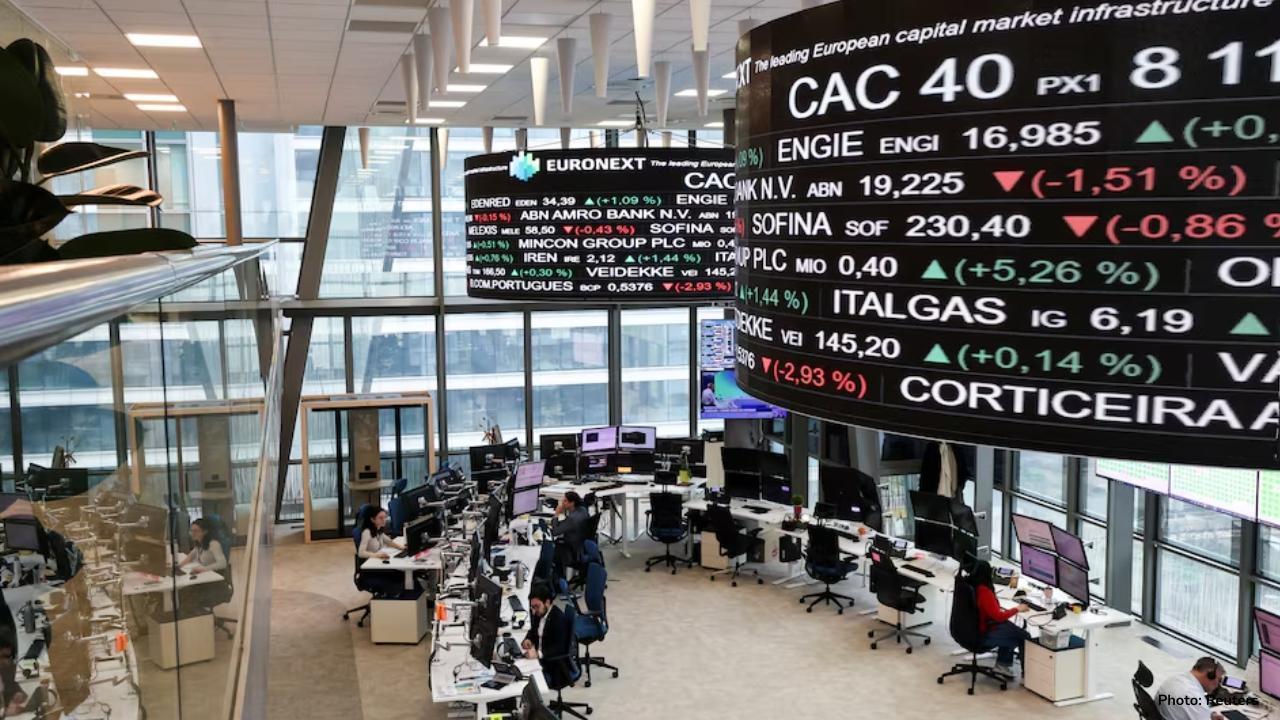
Post by : Monika
On October 9, 2025, global financial markets showed mixed performance, reflecting investor caution amid concerns about economic growth, inflation, and global market trends. European stock markets experienced declines in some key indexes, while other regions showed mixed or slightly positive results.
Investors around the world are closely watching economic data, central bank policies, commodity prices, and geopolitical events. All of these factors influence market stability and investor sentiment. The markets are sensitive to news about inflation, trade, and economic activity, and even small developments can create fluctuations in stock prices.
European Stock Market Performance
In Europe, stock markets showed varied results on October 9. The Stoxx 600, which tracks the performance of major European companies, declined by 0.6%. This drop reflected concerns about slowing economic growth and persistent inflation pressures in the region.
Germany’s DAX index fell by 0.5%, while France’s CAC 40 declined by 0.7%. Investors were cautious because recent economic data suggested that growth in Europe might be weaker than expected. Companies in sectors like technology, retail, and industrials faced uncertainty due to reduced consumer spending and higher costs of raw materials.
Meanwhile, the UK’s FTSE 100 gained 0.3%, led by increases in energy and mining stocks. Oil and natural resources companies performed well as commodity prices showed some recovery. However, the overall sentiment in European markets remained cautious, with investors weighing global risks and local economic concerns.
Economic Concerns in Europe
Investors are increasingly worried about the potential for a slowdown in the European economy. Many countries in Europe are experiencing slower manufacturing growth, reduced consumer spending, and high inflation rates.
Inflation has been a major concern for investors. Rising prices for goods and services affect both businesses and households. Companies face higher production costs, which can reduce profit margins, while consumers spend more on necessities, leaving less for other purchases. Central banks, such as the European Central Bank, are under pressure to balance inflation control with economic growth, a challenge that impacts market expectations.
Weak economic indicators, including slower industrial output and low retail growth, have added to investor caution. Many traders are monitoring economic data closely to anticipate whether central banks might adjust interest rates or implement policies to stabilize growth.
Global Market Trends
Global markets outside Europe are also experiencing volatility. In the United States, major indices such as the S&P 500 and the Nasdaq Composite showed mixed performance. Tech stocks, which make up a significant portion of these indexes, experienced small declines as investors weighed earnings reports against rising costs and inflation.
In Asia, markets were similarly unsettled. Trade concerns, supply chain disruptions, and geopolitical tensions influenced stock performance. Countries that rely heavily on exports, like China and Japan, are particularly sensitive to global trade developments. Investors are cautious as global supply and demand patterns shift.
Commodity markets have also been affected. Oil prices fluctuated due to concerns about supply disruptions and geopolitical issues in key oil-producing regions. Gold prices rose as investors sought safe-haven assets amid market uncertainty. Other commodities, like copper and wheat, showed mixed results depending on supply-demand dynamics and currency fluctuations.
Factors Affecting Investor Decisions
Investors consider several key factors when making decisions in a volatile market:
Economic Data: Indicators such as GDP growth, unemployment rates, consumer spending, and industrial production affect investor confidence. Weak data can signal slower growth and may lead to market declines.
Inflation: Rising prices influence central bank policies and interest rates. High inflation can hurt both companies and consumers, while moderate inflation may indicate a stable economy.
Central Bank Actions: The policies of central banks, such as the European Central Bank and the Federal Reserve, are closely monitored. Decisions about interest rates, bond purchases, and monetary stimulus can affect investment sentiment.
Global Events: Geopolitical tensions, trade disputes, natural disasters, and political instability can create market uncertainty. Investors often respond by adjusting portfolios to reduce risk.
Corporate Earnings: Companies’ quarterly and annual earnings reports indicate financial health and growth prospects. Strong earnings can boost stock prices, while weak results may lead to declines.
Market Sentiment: Investor confidence and market psychology play a crucial role. Even small rumors or news can create significant price movements if traders react strongly.
Sector Performance in Europe
Different sectors in Europe experienced uneven performance on October 9:
Energy and Mining: These sectors performed relatively well due to rising commodity prices, including oil, gas, and metals. Investors see energy companies as a hedge against inflation.
Technology: Technology companies faced pressure from rising production costs and slower consumer demand. Some tech stocks also reflected concerns about global competition and trade restrictions.
Retail: Retail stocks declined in several countries as consumer confidence weakened and households faced higher living costs.
Financials: Banks and financial institutions showed mixed results. Rising interest rates can boost bank profits, but higher inflation and economic uncertainty increase risk.
Industrial and Manufacturing: These sectors were cautious, reflecting concerns about supply chain disruptions, rising costs, and slower European economic growth.
Outlook for Investors
Looking ahead, investors should remain cautious but strategic. Diversifying portfolios across sectors and regions can help mitigate risks in volatile markets. For example:
Stable Sectors: Energy, healthcare, and utilities may offer more stability.
Emerging Opportunities: Technology, clean energy, and digital services may provide growth potential despite short-term fluctuations.
Safe-Haven Assets: Gold, government bonds, and certain currencies can protect portfolios from volatility.
Investors are advised to stay informed about economic reports, central bank announcements, and global developments. Understanding the long-term trends helps make informed decisions and reduces the risk of panic-driven trades.
The Role of Central Banks
Central banks have a key role in shaping market behavior. By adjusting interest rates, monetary supply, and policy statements, they influence both inflation and growth expectations.
In Europe, the European Central Bank (ECB) continues to monitor inflation and economic activity closely. Decisions about interest rate changes or stimulus measures can cause immediate market reactions. Investors track these decisions to anticipate their impact on sectors such as banking, real estate, and consumer goods.
Similarly, the Federal Reserve in the United States and other central banks globally play a role in market stability. Coordinated actions by major central banks can reduce market uncertainty and support global growth.
Impact of Global Geopolitics
Global geopolitical issues also affect investor sentiment. Tensions in key regions, such as the Middle East, Eastern Europe, or trade disputes between major economies, can create market volatility. Investors often shift funds to safer assets, such as gold or government bonds, when uncertainty rises.
Trade policies, sanctions, and international agreements also influence corporate earnings and investment decisions. Companies that rely on exports or imports are particularly sensitive to changes in global trade conditions.
Commodity Market Trends
Global financial markets on October 9, 2025, demonstrated mixed performance, with European stock markets facing challenges while other regions showed varied results.
Economic concerns, inflation, and geopolitical events were the main drivers of market volatility. Investors are advised to remain cautious, diversify portfolios, and monitor developments closely. Sectors such as energy, technology, and clean energy offer opportunities, while safe-haven assets like gold provide protection against uncertainty.
Central banks and policymakers play a crucial role in stabilizing markets, and their decisions will continue to influence investor confidence. Global collaboration, trade stability, and economic growth indicators remain important for long-term market trends.
while the markets are currently volatile, informed decisions, careful monitoring of economic indicators, and strategic diversification can help investors navigate challenges and take advantage of potential opportunities in European and global markets.










NBA Friday Recap: Powerhouse Wins for Miami, LA, Milwaukee, and Clippers
Miami, LA Lakers, Milwaukee, and Clippers triumphed in a thrilling NBA Friday, showcasing standout p

Doncic Shines with 49 Points in Lakers' 128-110 Victory over Timberwolves
Luka Doncic dazzles with 49 points as the Lakers secure a 128-110 win against the Timberwolves, show

Kings Triumph Over Jazz 105-104 with Last-Minute Sabonis Effort
The Sacramento Kings edged out the Utah Jazz 105-104, with Domantas Sabonis making the decisive shot

Argentina's Friendly Match Against India Delayed, New Date to be Announced
The friendly match between Argentina and India in Kochi has been postponed due to FIFA approval dela

Rohit and Kohli Conclude ODI Journeys in Australia with a Victory
Rohit Sharma and Virat Kohli bid adieu to Australian ODIs with a final win, forming a 168-run partne

George Russell's Wrestling Mask Antics at Mexican Grand Prix
George Russell donned a wrestling mask to enjoy the Mexican Grand Prix from the stands, providing a